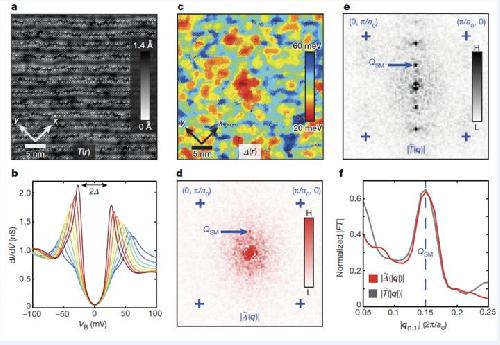The international scientific team reported the first ever observation of the atomic scale structure of Cooper-pairs in the superconductor Bi2Sr2CaCu2O8+x: a material belonging to the family of high-temperature (High-TC) superconductors bismuth strontium calcium copper oxide, or BSCCO. This detection is a breakthrough in the understanding of the ever elusive high-TC superconductivity phenomena.
Condensing fermions into one macroscopic quantum state
Conventional superconductors are not a recent discovery; conversely, they have been in commercial use for a number of decades but the extreme temperatures required, less than -263oC, prove difficult to attain and maintain, as opposed to high-TC superconductors where more manageable temperatures of -196oC are required. Superconductivity occurs under certain temperatures: electrons form pairs and suddenly the electrical resistance drops to zero and the magnetic field inside of the material is repelled.
 Figure 1.A: Typical 35 nm X 35 nm topographic image T(r) at BiO termination layer of BSCCO (crystal "supermodulation" runs vertically).
Figure 1.A: Typical 35 nm X 35 nm topographic image T(r) at BiO termination layer of BSCCO (crystal "supermodulation" runs vertically).
B: Typical g(E)=dI/dV(E=eV) differential tunnel conductance spectra of superconducting Bi2Sr2CaCu2O8. The maximum energy gap is determined from half the distance between peaks in each spectrum.
C: Spatial arrangement of ƒ´(r) (gapmap) for p~17% Bi2Sr2CaCu2O8 samples studied here in same 35 nm X 35 nm FOV as A.
D: Magnitude of Fourier transform of c, |? ?(?)| (crosses are at q=(π/a0,0);(0,π /a0))
E: As typical26, a single in equivalent peak due to the crystal "supermodulation" is observed (blue arrow).
F: Simultaneously measured magnitude of Δ(q) and t (q) from d,e along the (1,1) direction. Their primary peaks coincide exactly. Credit: IBS
In nature, there are examples of emergence of macroscopic quantum states - superfluidity, Bose-Einstein condensation for example- where bosonic particles (bosons) condense and form one macroscopic quantum entity. Electrons which are fermions--not bosons--cannot condense into one entity. However, under extremely low temperatures fermions cleverly combine into pairs and act as if they are bosons; they condense into one state and form yet another kind of macroscopic quantum phase - superconductivity.
Overcoming severe difficulties
The international scientific team had to overcome difficulties in creating an extreme environment. The process of detecting electrons is incredibly intricate, even when using advanced modern scientific machinery. Professor Jinho Lee, leader of the project, explains: "Even detecting electrons in atomic resolution using a scanning tunneling microscope (STM) requires extremely low temperatures, low vibrations and a vacuumed environment to prevent any decay in the tip of the microscope or the sample as well as to minimize any electrical noise. Detecting pairs is exponentially more difficult since the normal metal tip can only detect electrons and is unable to probe electron pairs. Naturally one needs to use a sharp, durable superconducting tip which is very challenging to make. Many researchers tried and failed. We solved this arduous problem by creating a superconducting tip in-situ using the same material as the sample. Cooper pairs can be detected due to the Josephson effect between the superconducting tip and sample. By using this Scanning Josephson Tunneling Microscopy, we were able to directly measure Cooper-pairs in atomic resolution for the first time."
Tunneling through barriers and looking toward the future
The Josephson effect is directly linked to superconductivity. Two superconducting materials, separated by a very thin barrier, can overlap their wave functions and Cooper pairs can tunnel through the barrier: This is known as the Josephson effect. Using the Scanning Josephson Tunneling Microscope, the team detected, at an atomic scale, the Cooper-pair tunneling through the barrier between the superconducting materials.
The team's results, published in Nature, announced the world's first measurement of atomic scale structure of Cooper-pairs. The implications of this discovery might not reverberate for many years in commercial applications of superconductors, but there is no doubt that the team altered the future path of superconductor research.
source: Institute for Basic Science